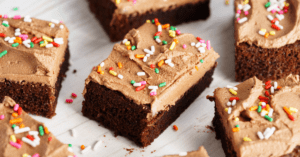Pastel de Tres Leches is one of the best cakes I’ve tried. Ever. And I’m so excited to share my recipe with you!
It’s a sponge cake, poked with holes and soaked in three kinds of milk. How delectable does that sound?!
And I love how easy it is to make, too. Even if you overbake the cake a little, that’s where the milk mixture comes in. You seriously can’t go wrong.
So, if you’re looking for a show-stopping dessert, the search is over. Pastel de Tres Leches is the winner!

What Is Pastel de Tres Leches?
Pastel de Tres Leches translates to “cake of three milks” in Spanish. It’s a sponge cake infused with three kinds of milk: condensed, evaporated, and heavy cream.
The cake absorbs the milk mixture, giving it its signature moist texture. It’s like custard or pudding- rich but not soggy.
Serve it with whipped cream, cinnamon, and fresh berries on top for a light post-meal treat.
Pastel de tres leches is also called milk cake, Mexican cake, and tres leches cake.

Ingredients
Sponge Cake:
- Flour- This base ingredient forms the cake structure. Sift the flour and measure it accurately for the best results.
- Eggs- Separate the yolks and whites for this recipe. Beat the egg whites into stiff peaks. This will help make the batter rise into a tall, fluffy cake.
- Sugar- To sweeten the cake. You only need simple white granulated sugar.
- Baking Powder- For added lift.
- Milk- To saturate the dry ingredients and create a liquid batter. Milk also adds richness to the cake.
- Vanilla Extract- Adds depth of flavor.
Tres Leches Mixture:
- A combination of three kinds of milk– Evaporated, sweetened condensed milk, and whipping cream. You will pour this over the warm cake.
For Serving: Whipped cream, cinnamon, and fresh berries.
How to Make Pastel de Tres Leches
If you enjoy creamy, rich cakes, like my go-to hot milk cake, I know you’ll like this recipe. Here’s how to make it:
1. Prep. Preheat the oven to 350 degrees Fahrenheit and grease your dish.
You’ll serve the cake in the baking dish. So, you may want it to be on the fancier side. A glass or ceramic casserole will be perfect here.
2. Beat the egg whites to stiff peaks. This step is crucial for the sponge. It makes it tall, light, and airy.
Once separated, beat the egg whites for 1 minute or until foamy. While beating, gradually add the sugar, 1 tablespoon at a time. Beat until stiff peaks form.
3. Add the remaining wet ingredients. Add the egg yolks, milk, and vanilla. Beat until well combined.
4. Carefully mix in the dry ingredients. Add the sifted flour and baking powder to the mixture. Do this 1 tablespoon at a time, mixing gently with a rubber spatula as you do.
Be sure to scrape the bottom and sides of the bowl to mix in all the ingredients. Be careful not to overmix.
Stop mixing as soon as you no longer see streaks of flour.
5. Bake the sponge cake. Bake the cake until a toothpick inserted into the center comes clean, about 20 minutes. Remove from heat and let cool on a wire rack.
6. Make the tres leches mixture. Combine the condensed milk, evaporated milk, and cream.
7. Poke the cake and pour the milk. Poke the cake all over with a fork. But be careful not to go all the way through.
Otherwise, the milk mixture will seep into the bottom. Pour the milk mixture over the warm cake.
8. Chill the cake. This is the hardest part! Let the cake cool to room temp and then chill it. The cake needs at least 1 hour of sitting in the fridge.
This will allow it to absorb the milk and turn it into a moist, custard-like treat. If you can wait longer, let the cake chill overnight.
Trust me, it is worth the wait.
9. Serve and enjoy! Slice the cake into squares and serve with whipped cream and cinnamon. You can also add fresh berries. Enjoy!

Tips for the Best Tres Leches Cake
- Stick to sponge cake. You can use other cake recipes for the base but stick to sponge cake. It’ll absorb the milk mixture well without getting soggy.
- Measure the flour accurately. A sponge cake is supposed to be airy. Adding more flour than needed will result in a heavy cake. Worse, your cake might not even rise.
- Use the spoon and level method. Fluff the flour with a spoon and transfer it into a measuring cup. Level it off with the back of a knife.
- Separate the eggs while cold. It’s easier. Then, let everything come up to room temperature.
- Use a clean and dry bowl and beaters. Any trace of water or oil can keep the egg whites from fluffing up.
- Don’t overmix the batter. Be ever so gentle in mixing once you’ve added the flour. Overmixing yields a tough and rubbery sponge cake.
- Use a pretty baking dish. You will use the same dish for serving the cake. A ceramic or glass casserole dish will be perfect.
- Be sure the cake is level. This ensures the cake absorbs the milk mixture evenly once baked. Pour and spread the batter evenly into the baking dish. Tap the dish on the counter several times to remove any air bubbles.
- Whipping up your own whipped cream? Freeze the bowl and beaters for 15 minutes. This will help the cream whip faster.
- Want more stable whipped cream? Add some gelatin. It’ll keep the cream from melting quickly.

Make-Ahead Tips
Tres Leches is the ideal cake for making ahead of time. It literally NEEDS time to sit.
Let the cake absorb the tres leches mixture for at least 1 hour before serving it.
But I recommend letting it sit overnight. The longer the cake sits, the better it’ll absorb the milk mixture. And the better it’ll taste.
Make Pastel de Tres Leches up to 1 to 2 days in advance. Cover it with plastic wrap or foil and refrigerate. Do not add the toppings yet.
When ready to serve, slice the cake and top with whipped cream, cinnamon, and fresh berries.
How to Store Leftovers
Pastel de Tres Leches will keep well for up to 4 to 5 days in the fridge. It’s supposed to be served cold, so always keep it in the refrigerator.
Be sure to cover the cake with either foil or plastic wrap.
Also, store the cake and toppings separately.
The whipped cream loses its stability over time. You don’t want a blanket of wet white stuff all over your cake, do you?
Don’t freeze the cake. Remember- there’s milk in this dessert. It’ll have an off-consistency when frozen and thawed, affecting the cake’s texture.











